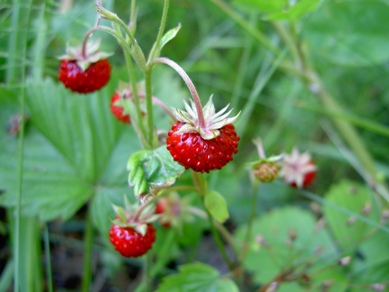A forager’s summertime delicacy.
Have you had your fill of Wild Strawberries this Summer? What a treat both to the eye and to taste. When ever I see Wild Strawberries I think of Faeries and expect them to be hiding under a leaf spying on me just like in my childhood story books.
This beautiful, dainty fruit is so delicious, packed with flavour and is a wonderful treat to find on an afternoon stroll through the countryside.
It can be found throughout Britain in woodlands, upon shady banks, hillsides and gardens, it enjoys rich soil. A perennial herb with a slanting branched rhizome, the leaves are toothed and veined, trefoil in shape with a paler, silky underside.
It flowers from April to June with flowers of five white petals and a cluster of yellow stamens. It fruits in June and July.
Don’t mistake Wild Strawberry for Barren Strawberry (Potentilla sterilis) which has similar leaves and flowers but the fruits are hard and dry, quite different from the juicy fruit of Wild Strawberry.
The leaves of Wild Strawberry can be used as a tea as a mild laxative and a diuretic and be used to treat kidney complaints. The leaves, crushed can also be used on abscesses and carbuncles or on freckles as an overnight treatment and other skin problems.
It is important to check with a professional herbalist before trying any herbal remedy. Wild Strawberries have also been used cosmetically for removing stains from teeth.
Wild Strawberry leaves and fruit can be added to salads and the fruit can be used in many summer deserts, shortbread, cakes or dried, bottled or frozen.
In folklore Wild Strawberries were used in love rituals and it was said that if you shared a double strawberry with someone that the two of you would fall in love. Because of their colour and heart shape, Strawberries were the symbol for Venus, Goddess of Love.

June 24, 2012 at 7:43 pm
A great little article. I’m a little late at reading it, but nonetheless, keep up the good work! Have you tried stinging nettle tea?! –
http://www.fayesforestschool.com/stinging-nettle-tea-anyone/